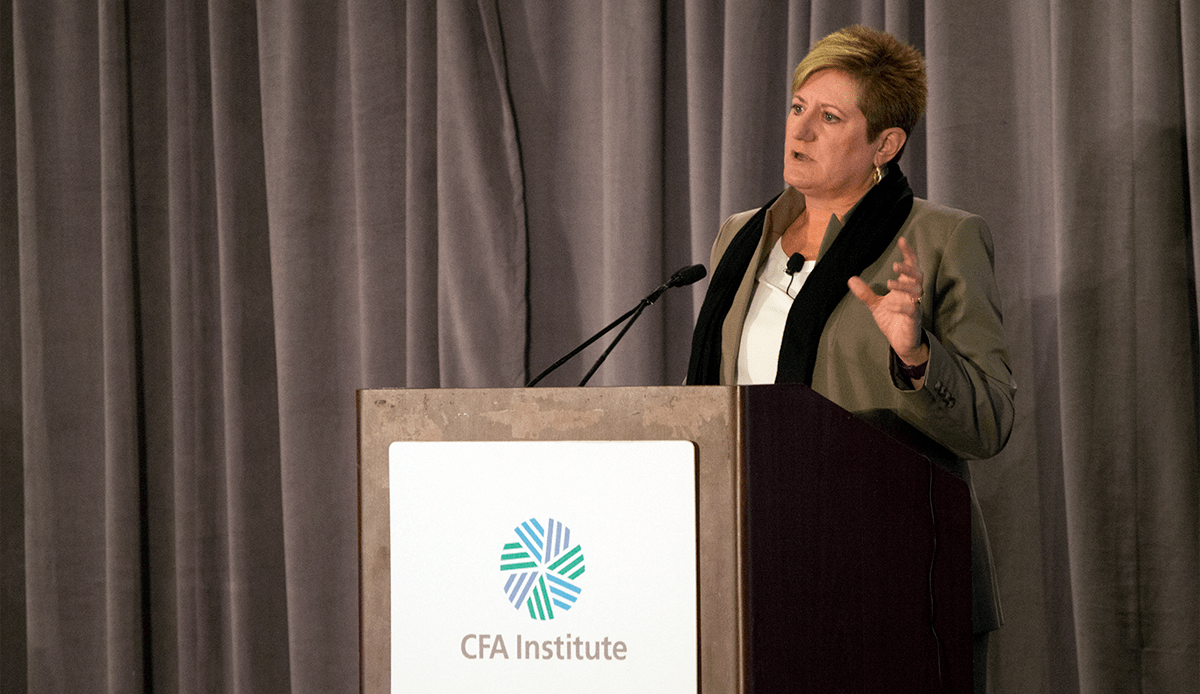[ad_1]
After 11 years of economic expansion, investors are preparing for trouble. Guggenheim fixed-income CIO Anne Walsh, CFA, has been keeping a close eye on economic indicators.
“Our firm has been in the camp of saying, ‘Yeah, recession risks are very, very high,’” Walsh said at the CFA Institute Fixed-Income Management 2019 Conference in Boston. “And they continue to be so.”
But don’t expect the end of the current cycle to be as dramatic as the global financial crisis (GFC). “The severity will probably be average, maybe even light,” she said. “We may not even get to a full recession. We may just get to a quote-unquote ‘slowdown.’ But that doesn’t change our view with regard to expected cumulative credit losses.”
Corporate liabilities are at an all-time high, Walsh noted. This means that a recession in the United States could trigger a painful wave of defaults in the bond markets. Some have already expressed concerns about BBB rated bonds potentially losing their investment-grade status, a possibility Walsh agrees does pose a significant risk.
A mass migration of investment-grade bonds to high-yield could overwhelm the high-yield market. “Just to give you a sense of size: The public high-yield market is about $1 trillion; leveraged loans are $1 trillion,” she said. “And remember that the BBB market is $5 trillion.”
Very little is certain in the current environment. “I don’t think I’ve ever seen a choppier market, more difficult to predict, than the one that we find ourselves in today as fixed-income investors,” Walsh said. “The signals aren’t very clear.”
The yield curve has been a particularly confusing indicator. “We’ve seen a tremendous amount of change in the shape of the yield curve,” she said. It has flattened, steepened, and inverted, taking every possible shape since 2008, Walsh observed. And it remains unstable and difficult to analyze.
“I would call it ‘kinked,’” she said. “Not exactly a fully inverted curve by any stretch, but certainly still indicating that we are not getting a clear signal from the yield curve about where we are right now.”
Some economic indicators — the US unemployment rate and the Conference Board Leading Economic Index (LEI), among them — suggest that rate cuts by the US Federal Reserve may be enough to avoid a recession. But declining consumer confidence suggests otherwise. “If you looked at small business confidence,” Walsh said, “I think the number would be even worse.”
The contradictory signals are hard to parse. “The question is,” she said, “do we need an economist, or do we need a psychologist?” But since consumer and small business confidence are the key factors that ultimately drive spending decisions and the Fed’s ability to influence economic behavior, they’re worth paying attention to. The message they’re sending now is cause for concern. Just how much concern remains to be seen. The future may hold a mid-cycle correction or a full-blown recession.
“We’ll absolutely know in the next couple of months which way we’re going to end up,” Walsh said.
If you liked this post, don’t forget to subscribe to the Enterprising Investor.
All posts are the opinion of the author. As such, they should not be construed as investment advice, nor do the opinions expressed necessarily reflect the views of CFA Institute or the author’s employer.
Image courtesy of Paul McCaffrey
[ad_2]
Image and article originally from blogs.cfainstitute.org. Read the original article here.

